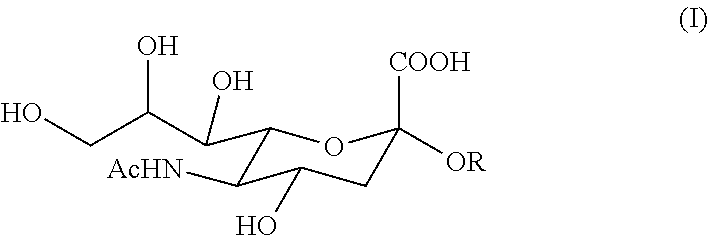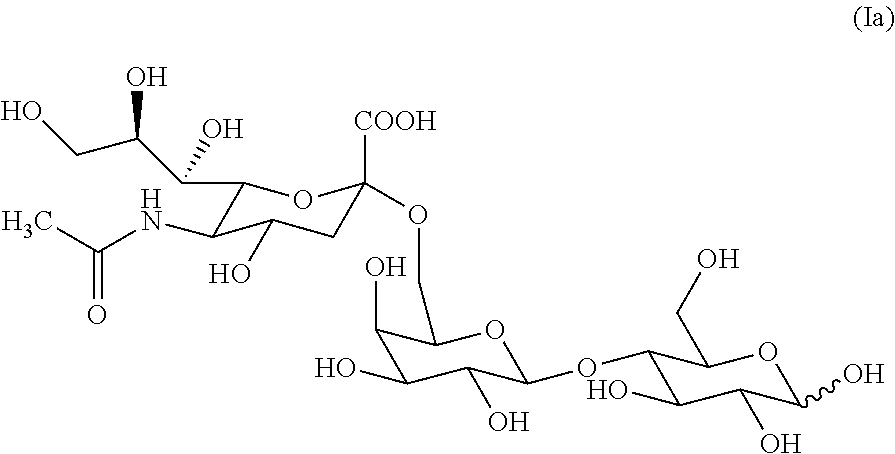6'-sialyllactose salts and process for their synthesis and for the synthesis of other alpha-sialyloligosaccharides
a technology of sialyloligosaccharides and salts, which is applied in the direction of esterified saccharide compounds, sugar derivatives, and aminosugars, etc., can solve the problems of limited availability of these enzymes, the use of ammonium salts is potentially toxic, and the use of these enzymes
- Summary
- Abstract
- Description
- Claims
- Application Information
AI Technical Summary
Benefits of technology
Problems solved by technology
Method used
Image
Examples
example 1
Preparation of di 4′,6′-O-benzylidenlactose
[0063]200 g (0.555 mol) of lactose monohydrate were added under stirring to 1.4 l of N,N-dimethylformamide and then 209 ml (1.39 mol) of benzaldehyde dimethyl acetal and 5.28 g (0.028 mol) of p-toluenesulfonic acid monohydrate were added. The resulting suspension was heated at 55° C. and the temperature was maintained until TLC was successful (16-18 hours) (Pharmacopoeia). After cooling at room temperature 4.7 ml of triethylamine were added until pH 7-8. The mixture was concentrated to obtain 700 ml of solution, which is drained in 3 liters of hot acetone (50-55° C.), maintaining a vigorous stirring. The precipitation was completed by cooling the mixture to 0±5° C. The precipitate was filtered, washed with 0.7 liters of cold acetone and dried, obtaining 208 g of 4′,6′-O-benzylidene lactose (mixture of α / β anomers) as white product (assay HPLC 66%, 0319 mol, yield: 57%).
[0064]By double crystallization, first by MeOH and then by MeOH / H2O 4 / 1 ...
example 2
Preparation of 4′,6′-O-p-methoxybenzylidenlactose
[0068]200 g (0.555 mol) of lactose monohydrate were added under stirring to 1.4 l of N,N-dimethylformamide and then 237 ml (1.39 mol) of p-methoxybenzaldehyde dimethyl acetal and 5.28 g (0.028 mol) of p-toluenesulfonic acid monohydrate were added. The resulting suspension was heated at 55° C. and the temperature was maintained until positive TLC resulted (16-18 hours) (Pharmacopoeia). After cooling at room temperature 5.0 ml of triethylamine were added until pH 7-8. The mixture was concentrated and the residue was crystallized in 3 liters of hot acetone (50-55° C.). The precipitation was completed by cooling the mixture at 0÷5° C. The precipitate was filtered, washed with 2×200 ml of cold acetone, obtaining 219 g of 4′,6′-O-p-metossibenzyliden lactose (mixture of α / β anomers) as a pale yellow solid (assay HPLC 76%, 0361 mol, yield: 65%) Crystallization from hot acetone / H2O 4 / 1 v / v gave an analytical sample as a dip anomeric mixture (1...
example 3
Preparation of 1,2,3,6,2′,3′-hexa-O-acetyl-4′,6′-O-benzyliden-β-D-lactose
[0072]100 g (0.153 moles from HPLC) of 4′,6′-O-benzylidenlactose obtained according to example 1 and 256 ml (1.84 mol) of triethylamine were added to 600 ml of methyl ethyl ketone. The reaction mixture was heated at 60° C. and 174 ml (1.84 mol) of acetic anhydride were dropped maintaining the internal temperature below 70° C. The reaction mixture was stirred at 70° C. until TLC was successful (10-12 hours) (AcOEt). The solvent was evaporated and the residue dissolved in 270 ml of dichloromethane and 200 ml of water. NaOH 30% was added under stirring up to pH 9-9.5, then the layers were separated; the aqueous layer was extracted again with 75 ml of dichloromethane. The collected organic layers were washed with 200 ml of water, and then HCl solution 32% was added under stirring up to pH 1-1.5. The acid aqueous layer was extracted with 75 ml of dichloromethane. The collected organic layers were then washed with 37...
PUM
| Property | Measurement | Unit |
|---|---|---|
| temperature | aaaaa | aaaaa |
| temperature | aaaaa | aaaaa |
| temperature | aaaaa | aaaaa |
Abstract
Description
Claims
Application Information
 Login to View More
Login to View More - R&D
- Intellectual Property
- Life Sciences
- Materials
- Tech Scout
- Unparalleled Data Quality
- Higher Quality Content
- 60% Fewer Hallucinations
Browse by: Latest US Patents, China's latest patents, Technical Efficacy Thesaurus, Application Domain, Technology Topic, Popular Technical Reports.
© 2025 PatSnap. All rights reserved.Legal|Privacy policy|Modern Slavery Act Transparency Statement|Sitemap|About US| Contact US: help@patsnap.com



